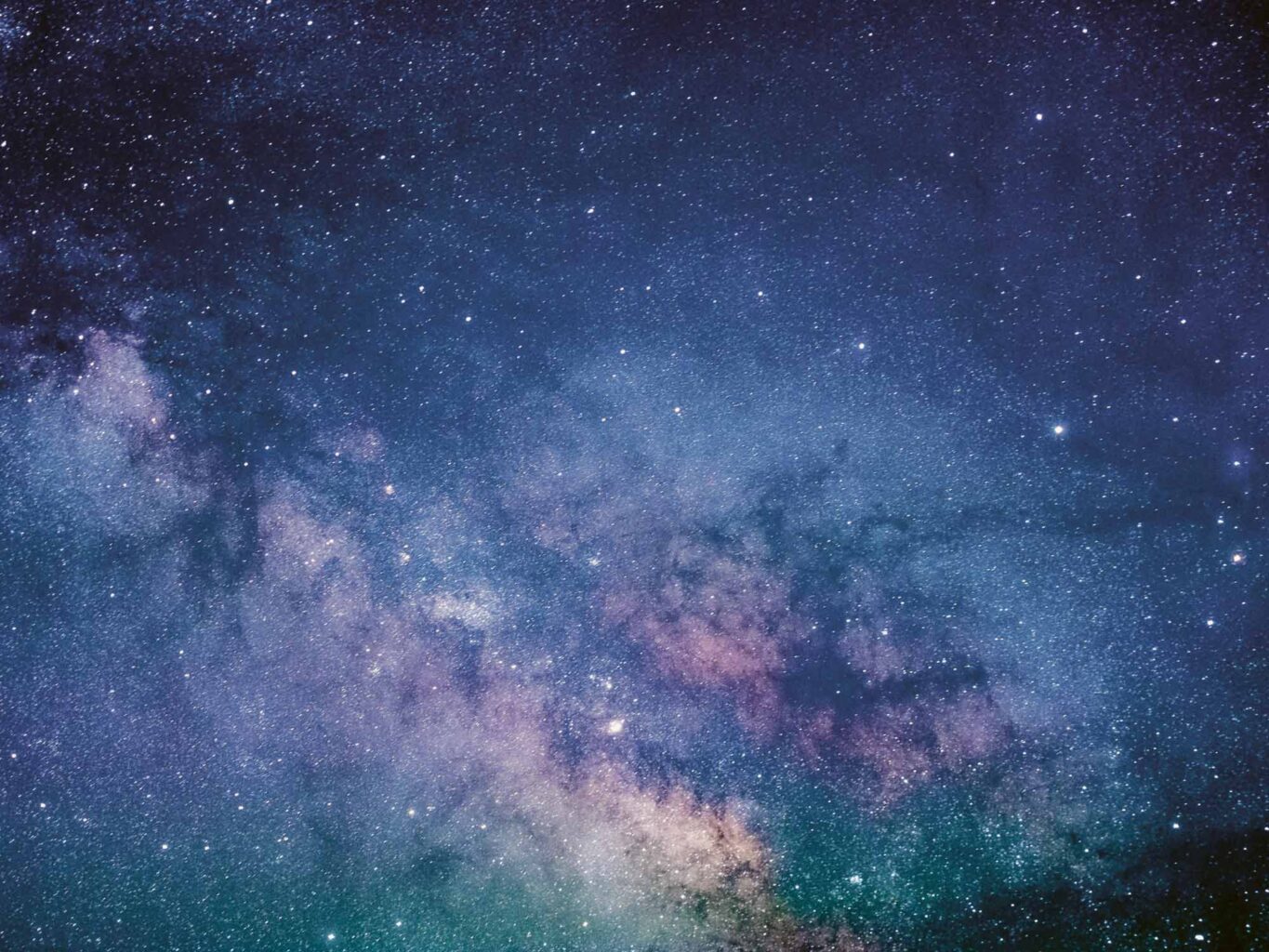Matthew E. Kenyon is a lifelong student of Rudolf Steiner as well as a Ph.D. physicist who has worked for NASA’s Jet Propulsion Laboratory for over twenty years on various projects including next-generation technology for future space telescopes beyond the recently launched James Webb Space Telescope. This essay reflects his effort to reconcile his spiritual and professional work.
From the perspective of conventional science, the cosmology of Rudolf Steiner found in his ‹Outline of Occult Science› and elsewhere in Anthroposophy appears fantastical. Why? Because conventional science assumes that past epochs of the evolution of Earth as well as the universe as a whole can be understood by extrapolating experiences of present conditions into the past. Perhaps in no other field of conventional science is this process of extrapolating present conditions into the past more conspicuous than in the field of modern cosmology. As will be discussed below, cosmologists unknowingly commit the error of thinking that the primordial universe is directly observable with their telescopes. They point their telescopes at very distant celestial objects and conclude they are seeing light that is billions of years old because it takes light this long to travel great cosmological distances. Because of this erroneous assumption, the conclusions of modern cosmology present a particularly stubborn obstacle for the acceptance of the cosmology of Occult Science because modern cosmology is heralded far and wide as the pinnacle of scientific achievement. The essay below attempts to show that cosmologists do not directly observe the universe from the past because the laws of nature themselves evolve over time according to higher spiritual laws, causing the light traveling in space to evolve as well.
This conclusion is at odds with modern cosmology, which sees the universe as a gigantic machine that evolves according to a set of fixed natural laws. The celebrated cosmologist Stephen Hawking summarizes this view by saying, «I believe the universe is governed by the laws of science. The laws may have been decreed by God, but God does not intervene to break the laws.» To state that the laws of nature themselves evolve is for Hawking and modern cosmology, in general, heretical. It amounts to saying that the laws of nature do, in fact, break. However, it is heretical only because, as this essay will discuss, cosmologists simply omit the existence of the human being from their scientific endeavors. They turn their telescopes outward to study the light streaming from distant celestial objects but do not turn to their own inner experiences as thinking beings who can grasp truth in the outer universe and in themselves. If they were to make themselves an object of study just like the objects within the field of view of their telescopes, they would realize that one cannot solve the riddle of the origin and evolution of the universe like one is merely solving a hyperdimensional Rubik’s Cube. The fact that we can experience truth and that knowledge exists at all demands an entirely different approach to cosmology, like the one found in Anthroposophy as will be discussed below.
Steiner emphasized this different approach, repeatedly saying to the workers of the Goetheaum, for example, «You see, an astronomer will say: ‹What I see with my naked eye does not impress me; I have a telescope. I rely on my telescope; it is my instrument.› The spiritual scientist will say: ‹Why bother with telescopes! Of course, you’ll see a great deal, and we acknowledge this. But the best instrument you can use to gain insight into the universe is the human being itself.› You perceive everything through the human being. The human being is the best instrument, for everything becomes apparent to it.»1
But to make ourselves an instrument that replaces the impressive Hubble Space Telescope or the recently launched state-of-the-art James Webb Space Telescope (JWST) does not require a technological revolution in the world around us, but, instead, requires a spiritual revolution within us. We must transform wholesale our capacity to think, which those of us who follow the teachings of Rudolf Steiner recognizes as a contemporary path of initiation. Humankind today experiences their thoughts in shadowy abstractions because humankind is caught in the web of intellectual materialism. The essay below attempts to show this fact by pointing out that modern cosmology rests on untenable assumptions. These untenable assumptions are not widely acknowledged simply because we have become wholly enchanted by abstract thinking and this mode of thinking fails to grasp its own origins.
Scientists hold a conviction that is rarely questioned – that the laws of nature have been the same since the beginning of the universe. All theorizing about the origin of the universe, the Earth, and the kingdoms of nature rests on this fundamental assumption that the laws of nature are constant over the life of the universe.
Based on this conviction, cosmologists study the light that comes to Earth from celestial objects (e.g. stars, galaxies, etc.) to answer the question «from whence did it all come?» Cosmologists assume that since it takes light traveling from distant celestial objects a very long time to reach their telescopes, they are actually observing the properties of these distant celestial objects as they were a very long time ago. For example, they conclude that the light now falling to Earth from our nearest galactic neighbor – the Andromeda Galaxy – is 2.5 million years old. They assume that this light that travels across the universe is a preserved time capsule. By dispersing this light into its spectrum (think of white light striking a prism), they are able to understand the nature of the celestial objects under study when these objects were very young. In particular, from the spectrum of light, cosmologists assume that important physically tangible properties like the chemical composition, temperature, and dynamics of these celestial objects can be determined as they were millions and even billions of years ago. In the field of modern cosmology, it is hard to overestimate the power of the assumption that the laws of nature never change. However, if we are serious and earnest in our striving to understand how all the things in our universe came into existence – from stars to plants to animals to, finally, ourselves – we must seriously question this assumption of the constancy of the laws of nature.
Scientists hold a conviction that is rarely questioned – that the laws of nature have been the same since the beginning of the universe.
First, we must awaken to the fact that everything we experience through our senses occurs in the present. When we observe distant stars and galaxies with telescopes that extend the reach of our senses and form concepts with our intellect about these sense phenomena, we are stuck in our present epoch. We can only conjecture that the light we receive from distant stars and galaxies is an unaltered time capsule with treasures from the past. We can speculate intellectually about these sense phenomena by assuming that the laws of nature have always been constant, but does the evidence support such an assumption?
To answer this question, let us turn to our inner experience. If we are open-minded and unbiased, it is only natural to include our inner experience when we study the light that falls on our telescopes. We use the light as a fact to draw conclusions about the origin of the universe, but our inner experience also presents itself as an undeniable fact. Typically, introspection has no place in cosmology. This science deems implicitly that our conscious experiences are merely subjective and, hence, an unimportant factor in studying the universe.
However, cosmologists use thinking to grasp the laws of nature while at the same time they deem thinking merely subjective. This is an untenable paradox that emerges from intellectual materialism. The hallmark of intellectual materialism is that it does not give thinking its rightful place in the universe – a universe we note that includes both light from celestial objects and human thought. If we are able to wrestle free from intellectual materialism and come to see that the inner experience of thinking itself transcends categories of objectivity and subjectivity, then we have no trouble casting aside the creed that the laws of nature have always been constant. Why? Because the evidence of our inner experience of thinking reveals directly to us the impossibility that one set of fixed natural laws that form the universe could simultaneously form our inner experiences. How can the laws of electromagnetism, for example, give rise to the laws of thinking? When we think thoughts about the laws of electromagnetism, we are not bound to these laws. The laws of thinking work in an entirely different way than the laws of electromagnetism. The laws of thinking can lead us to grasp the truth while the laws of electromagnetism simply act in the external world (here we include the brain among the things of the external world).
Mainstream science, simply put, does not understand thinking. Mainstream science equates thinking to mere brain activity. This is important because the approach to thinking itself from the dominant paradigm of mainstream science eclipses our capacity to recognize how thinking stands on principles outside the nexus of natural law. When we finally have the ah-ha moment of pure thinking which means nothing more than that we work directly with the laws of thinking, we recognize a higher ordering principle must harmonize the truth of the laws as we observe them in the outer universe and the truth of the laws as we think them in our inner experience. (Pure thinking is discussed in Rudolf Steiner’s The Philosophy of Freedom and we can only touch on a certain aspect of pure thinking to support the conclusions of this brief essay.)
Once outside the grip of intellectual materialism, recognizing our direct experience of truth in the outer universe as well as in our inner experience, we discover that our thinking is a gateway to the spirit and come to experience this spirit as the higher ordering principle. We reach an alternative conviction to that of the modern scientist: that natural laws are the consequence of spiritual laws. Unfortunately, this new conviction introduces a deep chasm between modern science and the person that awakens to the objective existence of the spirit, but this chasm is unavoidable. If striving for the whole truth truly motivates us, then we have no choice but to accept that modern scientists hold convictions that do not measure up to experience. We must conclude that the cosmologists’ assumption that the light from distant objects is fundamentally unaltered during its journey to Earth is untenable.
Instead, we state as a fact that, while light travels through interstellar space, its nature evolves, because the physical world is actually bounded by the spiritual world and the spiritual world evolves according to its own laws. This is not intellectual speculation because our mere existence as thinking beings who can grasp truth in the outer universe and in ourselves demonstrates the veracity of the above statement; however, admittedly, this is not easy to see. To reach such a conclusion demands that we break away from our enchantment with our vision of interstellar space and the cosmos as a whole which has emerged since the era of modern cosmology was initiated by Galileo, Kepler, Copernicus, and others many centuries ago. This vision sees the cosmos as a machine of staggering dimensions run by fixed laws and humanity itself as utterly irrelevant to the cosmos’ intrinsic nature and evolution. Rudolf Steiner’s teachings can be of great service here because his teachings reveal how the macrocosm surrounding us and the microcosm within us constitute two halves of a single unified whole.
If we turn to these teachings and focus on the microcosm, we learn how humankind evolves in body, soul, and spirit through various epochs. For example, we learn how human beings slowly developed the capacity to perceive the outer world in colors and shapes from primordial Atlantean times. We learn that for human beings to develop this capacity to experience pictures of the outer world within their field of consciousness as they do today, profound alterations to the constitution of human beings on the level of body, soul, and spirit had to occur over vast stretches of time. But for something like the power of sight to arise within the microcosm defined by human beings, the macrocosm and the laws of the physical world had to evolve as well. In other words, during primordial Atlantean times, the conditions of our world were so different that the laws of physics as we know them today were simply different. This is not so far-fetched when we recognize that there is only one world process that governs the outer world of the cosmos and the inner world of humanity. This is a key point of Steiner’s teachings and of this essay.

These kinds of observations are completely lost on modern cosmology with its one-sided empirical approach to the study of nature. If modern cosmologists follow the inter-disciplinarian empirical approach initiated by Rudolf Steiner and attempt to understand why through their eyes they actually see pictures in their consciousness, then they might be willing to conclude that during flight, light experiences evolution just like everything else in the universe. They might be open to the conclusion that as the spiritual world transitions from epoch to epoch, the laws of physics throughout the spacetime continuum and the continuum itself are not spared. (The details of how the spiritual – or supersensible – and physical laws evolve can be determined by cosmosophists who embrace proper methods of research as discussed below. In fact, Anthroposophy says much about this evolution). A consequence of these considerations is that the cosmologist is barred access to direct observations of the primordial conditions of the universe. The actual conditions of the primordial universe can never be directly experienced with a telescope. The telescope can only show evolving phenomena governed by a higher spiritual (e.g. supersensible) order.
Of course, this is an astonishing claim from the perspective of modern cosmology. Why is it not more widely acknowledged? Because modern cosmology does not use the instrument of pure thinking to reach conclusions. Instead, modern cosmology uses shadowy abstract thoughts bound to intellectual materialism to interpret sense facts. Modern cosmology and conventional science, in general, use insufficient methods of observation. It is not possible to know that the laws of nature evolve through our senses because our senses are bound to the nexus of physical laws that define the present universe. We have to break free from our senses to see behind the veil of our senses to witness how the spirit governs the evolution of the physical universe. Pure thinking provides the method by which we can do this.
The conclusions expressed above are fully substantiated by Rudolf Steiner where, for example, in Interdisciplinary Astronomy, he says, «We must distinguish, in the genesis of the Earth as well, between two phases: One in which active forces work in such a way that the real Earth itself is created, and then a later phase of evolution, in which the forces work so as to create the human faculty for understanding the realities of the Earth. Only in this way, my dear friends, do we really come near to an understanding of the Universe.»2 This quote implies the laws of nature today cannot be the same as in an earlier phase when the «real Earth itself is created.» We should think of the seven days of creation here. Each day of creation is, in fact, an epoch in which the principles or laws governing this epoch are different. A consequence of this is that the light traveling from the edges of the universe cannot really be the same light from the beginning of time. The light that appears to come from the beginning of time is light suited for the present epoch. What makes this light suitable? Karma. It is our karma that ultimately determines the nature of the light we observe in our telescopes. Again, this is why it is so important to turn to pure thinking as a method by which to grasp the foundation of the universe.
As radical as this conclusion may be for the modern cosmologist and for educated persons, in general, there is only one solution to knowing the origin and evolution of the universe: the cosmologist out of their striving to answer the question, «from whence did it all come» must transform their own nature and become a ‹cosmosophist› – a scientist of the spirit – if they are to discover a satisfactory answer to the important questions in life. They must adopt a new method of understanding the evolution of the universe. As Steiner continues to say from the quote above, «You may say: Well and good, but this method of understanding is less secure than the method used today with the aid of microscope and telescope. It may be that to some people it appears less secure. But if things are so constituted that we cannot reach the realities with the methods in favor today, then we are faced with the absolute necessity of comprehending reality with other modes of understanding and we shall have to get used to developing those other methods.»3
Those other methods are found in Anthroposophy and constitute the path of initiation. A cosmosophist is a person who undergoes the process of initiation by which they then use their whole person (body, soul, and spirit) to enter the spiritual world to understand how spiritual laws express themselves in the physical world. By transforming themselves, they are able to cross the threshold into the spiritual world, making themselves into an instrument suitable to travel beyond our current epoch and to grasp the origin of the universe in a way that fulfills the deeper needs of our humanity. We cannot separate questions regarding the origin of the universe from our own humanness. The two are fundamentally united by the higher order of the spirit and we can experience this unity if we banish from our intellect unreal suppositions that live at the heart of intellectual materialism. The assumption that the laws of nature have always been constant is just such a supposition.
We cannot separate questions regarding the origin of the universe from our own humanness.
As a final thought, this transition to spiritual science is not necessary for the technologists who set themselves a different task. Since technology works with the present laws of nature, we need to recognize that the existence of technological marvels, from the iPhone to the James Webb Space Telescope (JWST), does not rest on the assumption that the laws of nature have always been the same. Technologists borrow present processes from nature to invent material contrivances with a given purpose (e.g. technology). The achievements of technology must be kept separate from the speculative extrapolations of cosmologists who think they can directly observe past epochs from our present epoch by studying light from distant celestial objects with the latest telescopes. Unfortunately, these speculative extrapolations are given credibility because people unknowingly lumped together the unreal suppositions of scientists who indulge in intellectual game-playing about the past with the very real technology that dominates our culture today.
The threads of this article are continued in the author’s Q+A on Cosmosophy with a colleague.
Footnotes
- Rudolf Steiner, From Beetroot to Buddhism…: Answers to Questions, (Rudolf Steiner Press 1999), CW 353.
- Rudolf Steiner, Interdisciplinary Astronomy: Third Scientific Course, (Steiner Books 2020), CW 323.
- Rudolf Steiner, Interdisciplinary Astronomy: Third Scientific Course, (Steiner Books 2020), CW 323.










When I’m not ready reading the choosen article and i like to read the same article further, your system tells me that I read it already! Today my secure browser refused to load it because and told me that your site (via the link in my email) is not safe. So I used another browser but yor site gave me the message: “You have read your free monthly article”
So I couldn’t read it at al. In the past my solution for this problem was to download the article in my computer’s memory.
Kind regards
Thanks for this excellent article, Matthew. In Occult Science, Steiner says that each planetary sphere includes the area circumscribed as that planet orbits the Sun. And when we look at Saturn, Jupiter and Mars, we are looking at the previous stages of Earth’s etheric development, so when we look beyond the solar system, we are looking out from the life ether, through the 3 older ethers – 3 different types of space. Relativity is a clever mathematical construct to hide the effects of these ethers – “gravitational lensing” is almost certainly due to the presence of the warmth ether. In his book “Seeing Red”, Halton Arp says that red and blue shift are simply a measure of the age of a stellar body, not distance from Earth. This leads to disturbing conclusions – the 8th sphere is already being constructed by trapping us in a strictly materialistic worldview. I put this short book together in 2018 –
https://www.amazon.co.uk/Physics-Void-Exploring-nature-space/dp/1719402698.
Thank you
Douglas Gibson
I very much enjoyed this thought provoking article and comments from Mr. Gibson. I tried to find somewhere that Steiner may have discussed the changing laws of nature and found that the law of conservation of energy should not apply to man but does no harm when applied to the mineral, plant or animal kingdom (The Study of Man lecture 3). In the Genesis series lecture 1 it states that the laws which prevailed on Saturn were the very same laws which pertain today in the solid mineral kingdom. Since Steiner often presented topics from apparently contradictory perspectives it very well could be that the laws of nature change over time. I will ponder this article and comments for quite awhile.
Alan Klimek
I am not sure I would go that far to claim that the laws of nature are changing. I would argue however that generic assumptions in the current science (see below), make that theories about “history of the universe”, “history of time”, “big bang theory” (not the TV show, that was excellent !) are pure nonsense. ….. that is, assumptions such as:
– All the laws of nature that are manifesting on Earth in our times are all that exist and have ever existed anywhere anytime in the Universe. But, for ex. do the scientists know the laws at work during a Pralaya, or at the beginning and the end of such a period ?
– All interactions between the physical and the spiritual are ignored … say, How the heat reminiscent from the Saturn stage of development of our planet, is considered in the current physics ? or How the heat received from the Sun depends on the work of the spiritual entities residing there ?
– All the laws of nature observed on Earth are fully understood … excepting those which are not, situations when the observations are postulated to be in the realm of UFOs, aliens, “paranormal”, etc. and ignored accordingly by scientists.
Having said this, I have to give credit to those theories, whose validity for the very immediate here and now, is confirmed by technologies (from telecommunications to nuclear energy to the use of pigments in the paint industry, the list is too long) which work as intended. But, I would argue, even in these cases, the actual theories are describing only approximately (excellent approximations, I may add) the reality.